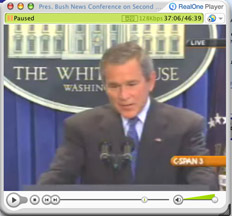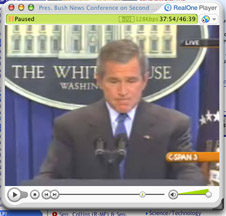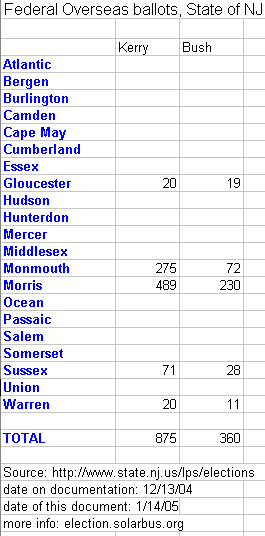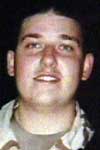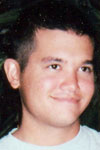Sending this on to Senators, members of Congress, media...
Easy-to-read & share pdf file at < http://www.bpac.info >.
:bounce:
===============================
The Case for Fraud in Ohio Election 2004 (Outline)
I. Voter Suppression
A. Overly Restrictive Registration Requirements
B. Incompetence in Processing Registrations
C. Challenges to New Registrants on Insufficient Grounds
D. Misinformation About Voting Status/Location/Date
E. Voter Intimidation
F. Voting Machine Shortages/Malfunctions
G. Overly Restrictive Rules & Incorrect Procedure Regarding Provisional Ballots
H. Poorly Designed Absentee Ballots Caused Voters to Mark Incorrect Candidate
II. Access to Voting Systems Before Election Violates Protocol
III. A Third-Rate Burglary in Toledo
IV. Suspect Results
A. Registration Irregularities
B. Exceptionally High Voter Turnout
C. More Votes than Voters
D. Exceptionally High Rates of Undervotes
E. High Rate of Overvotes Due to Ballots Pre-Punched for Bush?
F. The Kerry/Connally Discrepancy
G. Discrepancy between Exit Polls & Tabulated Votes
V. Restricting Citizen Observation & Access to Public Documents
A. Warren County Lockdown
B. Restricting Citizen Access to Election Records
VI. What Went Wrong with the Recounts/Investigation of Vote Irregularities
A. Chain of Custody of Voting Machines & Materials Violated
B. Failure to Follow Established Procedures for Recounts
C. Failure to Allow Recount Observers to Fully Examine Materials
D. Secretary of State Blackwell has Failed to Answer Questions
VII. Recount Reveals Significant Problems
VIII. Methods of Election Fraud
A. Stuffing the Ballot Box
B. Touchscreen voting machines appear to have been set to “Bush” as Default
C. Computers pre-programmed to ‘adjust’ vote count in Bush’s favor?
D. Tampering with the Tabulators: Evidence of Hacking in Real-Time?
IX. Additional Observations
A. Irregular/Impossible Changes in Exit Polls over time on Election Night
===============================
I. Voter Suppression
A. Overly Restrictive Registration Requirements. According to Representative John Conyer’s letter to Kenneth Blackwell (12/2), Blackwell’s 9/7/04 directive to reject voter registration forms not printed on white, uncoated paper of not less than 80 lb text weight resulted in many valid voter registration forms being rejected. While Blackwell reversed this directive, he did not do so until 9/28/04. Not all counties were informed when the directive was reversed – some were advised of the change by the news media.
B. Incompetence in Processing Registrations. Moss v. Bush alleges that in the Cleveland Area (Cuyahoga County), the Board of Elections botched the registrations of more than 10,000 voters, preventing them from voting.
C. Challenges to New Registrants on Insufficient Grounds. Statewide, about 35,000 new voters had their registration challenged, apparently by the Ohio State Republican Party. In Summit County, four elderly residents were asked by a member of the local Republican Party to fill out and sign 976 registration challenges for people on a list. The names on the list were those of new registrants who had been sent registered mail by the Republican Party. Delivery was attempted only once, and if the person was not home, or refused the mail, they were placed on the list. This attempt at suppression impacted many long-time residents of Summit County including a veteran and an immigrant (“I came to this country because this is a great country…“). The Summit County Board of Elections dismissed all 976 challenges after hearing the testimony of just a few people so accused. The four people who signed the challenges may be prosecuted.
D. Misinformation About Voting Status/Location/Date. Civil rights violations in Ohio were egregious. In Lake County, voters received a memo on bogus Board of Elections letterhead informing voters who registered through Democratic and NAACP drives they could not vote. In the Cincinnati area, African American voters received letters on official-looking letterhead, phone calls, and ‘door-hangers’ that directed them to the wrong precinct on Election Day. African American voters received letters on stolen NAACP letterhead claiming that because of the expected high turnout, Republicans were asked to vote on Tuesday Nov. 2 and all other parties were being asked to vote on Thursday, November 4. In the Cleveland and Columbus areas, voters received calls incorrectly informing them their polling place had been changed.
E. Voter Intimidation. According to the Ohio Free Press, a team of 25 men calling themselves the "Texas Strike Force" positioned themselves at a hotel across the street from Republican Party headquarters in Franklin County, Ohio (Columbus), and proceeded to make intimidating phone calls to likely Democratic voters, "targeting people recently in the prison system." The Texans' rooms were reportedly paid for by the Ohio Republican Party. A "hotel worker heard one caller threaten a likely voter with being reported to the FBI and returning to jail if he voted" — a crime if committed by an individual, but a much more serious act if engaged in by the entire interstate flying squad and any Republican group that paid, accommodated or sent them on their felonious mission. Local law enforcement was called.
F. Voting Machine Shortages/Malfunctions
Columbus Area (Franklin County): According to Representative John Conyer’s letter to Kenneth Blackwell (12/2), throughout predominately Democratic areas in Ohio on election day, there were reports of long lines caused by inadequate numbers of voting machines. The Franklin County voting machine allocation report states that 2,741 voting machines were placed “By Close of Polls” on Election Day. The County’s records reveal that they had 2,866 “machines available” on Election Day. At least 125 machines remained unused, even though the Board of Election’s Director Matt Damschroder (former Executive Director of the Franklin County Republican Party) admitted on 11/19 that 77 machines malfunctioned during the day. In some precincts there were fewer voting machines on Election Day than there had been during the spring primary. Additionally, it appears that in a number of locations, polling places were moved from large locations, such as gyms, where voters could comfortably wait inside to vote to smaller locations where voters were required to wait in the rain.
An analysis by Tim Lohrentz estimates that at least 22,000 Franklin County voters were disenfranchised due to the long lines and lack of voting machines, including over 15,000 voters from heavily Democratic (> 60%) precincts. Of the 217 precincts where there were fewer voting machines in 2004 than in 2000, 184 (85%) were Democratic. (A pdf file of the report is here: http://www.indybay.org/news/2004/12/1708672.php ).
The Free Press has obtained a list of all voting machines assigned in Franklin County, including serial numbers. The list contains at least 42 machines originally assigned to predominantly African-American and inner city wards that voted 80% for Kerry, and where voters waited in line for three hours and more on Election Day. These 42 machines were blacked out on the list, raising the question of whether these were among the 68 machines the Franklin County Board of Elections has admitted holding back in the warehouse despite obvious shortages at certain polling places. Affidavits from poll workers confirm that numerous requests for more machines were made throughout election day, but that few if any were delivered.
Toledo Area: Lucas County Election Director Paula Hicks-Hudson said the Diebold optical scan machines jammed during testing in the weeks before the election. Jammed or inoperable machines were reported throughout the city. Moss v. Bush alleges that there was discriminatory assignment of more voting machines to precincts with a majority of white voters than to precincts that had a majority of African American voters.
Cincinnati and Mount Vernon Areas: Moss v. Bush alleges that in Hamilton and Knox Counties there was a discriminatory assignment of more voting machines to precincts with a majority of white voters than to precincts that had a majority of African-American voters.
Youngstown Area: There were voting machine errors in Mahoning County when 20 to 30 ES&S iVotronic machines need to be recalibrated throughout the voting process due, in part, to reports of votes for Kerry appearing as votes for Bush.
G. Overly Restrictive Rules & Incorrect Procedure Regarding Provisional Ballots
Cincinnati Area: Across the state of Ohio voters could cast a provisional ballot, which was counted only if they were in their home precinct. According to Representative John Conyer’s letter to Kenneth Blackwell (12/2), in Hamilton County, officials have carried this problematic and controversial directive to a ludicrous extreme: they are refusing to count provisional ballots cast at the correct polling place if they were cast at the wrong table in that polling place. A Green Party recount observer learned that approximately 400 of the Hamilton County provisional ballots were rejected because they were cast at the wrong table (precinct) in the right polling place.
Cleveland Area: Moss v. Bush alleges that in Cuyahoga County there was an effective denial of the right to cast a provisional ballot and have that ballot counted. About 1/3 of the provisional ballots cast (8,099 ballots) have been incorrectly ruled invalid because they voter allegedly wasn’t registered or voted in the wrong precinct. In 2000, about 17% were ruled invalid.
Stark County: Moss v. Bush alleges that in Stark County there was an effective denial of the right to cast a provisional ballot and have that ballot counted. The Election Board rejected provisional ballots cast at the wrong precinct in the right polling place. In earlier elections, a vote cast in Stark County in the wrong precinct at the right polling location would be counted.
H. Poorly Designed Absentee Ballots Led Voters to Mark Incorrect Candidate. Moss v. Bush alleges that in the Cleveland (Cuyahoga County) and Columbus (Franklin County) areas there were voting machine errors with respect to absentee ballots. Like the infamous “butterfly ballots” in the 2000 Presidential Election, arrows on the absentee ballots did not align with the correct punch hole. On information and belief, this led to voters casting a vote for a candidate other than the candidate they intended to support.
II. Access to Voting Systems Before Election Violates Protocol
Auglaize County. In a letter dated Oct. 21, 2004, Ken Nuss, former deputy director of the County Board of Elections, claimed that Joe McGinnis, a former employee of ES&S, the company that provides voting systems in Auglaize County, had access to and used the main computer that is used to create the ballot and compile election results. Mr. McGinnis’ access to and use of the main computer was a violation of county board of elections protocol. After calling attention to this irregularity in the voting system, Mr. Nuss was suspended and then resigned.
III. A Third-Rate Burglary in Toledo
An article appeared in the Toledo Blade on October 13, 2004. Written by Robin Erb, it included the following: “Thieves shattered a side window overnight at Lucas County Democratic headquarters in Toledo, stealing computers with sensitive campaign information and jeopardizing the party's ability to deliver crucial votes on Election Day.
Among the data on the stolen computer of the party's office manager were: e-mails discussing campaign strategy, candidates' schedules, financial information, and phone numbers of party members, candidates, donors, and volunteers. Also taken were computers belonging to a Lucas County Commissioner and to a Texas attorney working with the Kerry campaign to ensure election security.
At Democratic headquarters, officials stopped short of publicly blaming partisan politics, but at the same time, they all but ruled out run-of-the-mill criminals. Two other computers, holding less sensitive information, were untouched, as were a petty cash box that usually holds $80 to $100, televisions, portable radios, and other electronics. Moreover, other offices inside the building, 1817 Madison Avenue, were not entered. Files, papers, and pamphlets remained in neat piles, and campaign signs leaned, apparently undisturbed, against a wall.”
Thus, the burglary gave the thieves exclusive possession of two months’ worth of Democratic voter canvass records. It may have allowed them to target specific wards and precincts for voter suppression operations, and left the Democrats unable to prevent it.
IV. Suspect Results
A. Registration Irregularities According to Representative John Conyers’ letter to J. Kenneth Blackwell (12/2), there appears to be an extraordinarily high level of voter registration in Perry County: 91%. A substantial number of these voters have never voted and have no signature on file. An extraordinarily large number of these voters are listed as having registered in 1977. In fact, 3,100 voters apparently registered in Perry County on November 8, 1977.
B. Exceptionally High Voter Turnout. According to Representative John Conyers’ letter to J. Kenneth Blackwell (12/2), in Miami County (Concord Southwest precinct) voter turnout was a highly suspect and improbable 98.55%. The certified result showed 520 votes for Bush and 157 for Kerry. This statistically improbable turnout has all but 10 of the 689 registered voters casting their ballots on Election Day. A preliminary canvas by The Free Press of less than half the precinct found 25 registered voters admitting they had not voted. In nearby Concord South precinct, there was a highly improbable 94.27% voter turnout. Miami County election results indicated that 18,615 votes came in after 100% of the precincts had reported. It is statistically suspicious that the extra votes came in at essentially the same percentage for candidates Bush and Kerry both before and after the 18,615 votes were counted Senator Kerry had received 10,724 votes (33.92%) of the vote after 100% of the precincts had reported. After the additional 18,615 votes were added, his percentage remained 33.92%.
C. More Votes than Voters
(1) Discrepancies Between Number of Registered Voters & Number of Votes in Franklin County: According to Representative John Conyers’ letter to Kenneth Blackwell (12/2), a computerized voting machine in Ward 1B in the Gahanna precinct of Franklin County recorded a total of 4,258 votes for President Bush and 260 votes for John Kerry. However, there are only 800 registered voters in the Gahanna precinct. A computer glitch results in recording 3,893 extra votes for Bush. Fortunately, this glitch was caught and the numbers were adjusted to show President Bush’s true vote count at 365 votes to Senator Kerry’s 260 votes.
(2) Discrepancies Between Number of Pollbook Signatures & Number of Votes
Perry County: According to Representative John Conyers’ letter to Kenneth Blackwell (12/2), the sign-in books in Reading S precinct show that fewer than 400 total votes were cast in that precinct. Yet, the precinct’s official tallies indicate that 489 votes were cast. Monroe Township, Precinct AAV has 226 voter signatures in the poll books and reports 393 votes were cast. In W Lexington G AB, 350 voters are registered. Yet, 343 votes have been reported. Perry County BOE has since issued a correction: Only 217 votes were cast for either Kerry or Bush. The BOE explanation is that some votes were initially counted twice. Representative Conyers’ letter notes that it is highly improbable that every ballot was counted twice.
Michael Kolman, attorney for Bill Crane (Democratic Party Candidate for Perry County Auditor), checked county voting records and alleges the number of votes cast exceeded the number of people who signed the books in at least 11 of 46 precincts. Approximately 90 voters did not sign in at one precinct, according to Kolman. At another precinct, 21 people who voted by absentee ballot also signed the signature books.
Youngstown (Trumbull County): A careful review of nearly 200 precincts in Trumbull County by Dr. Werner Lange revealed a considerable discrepancy between the number of certified absentee votes and the number of registered absentee voters identified in the poll books. The poll books are to contain not only the name of every registered voter, but also clearly identify who voted (either by regular, absentee or provisional means) and who did not. The Trumbull County investigation showed some 650 more absentee votes than there were absentee voters identified in the poll books examined. If the absentee vote inflation rate there were consistent statewide, then over 63,000 votes were up for grabs in Ohio. A case filed in mid-November with the Trumbull County Court of Common Pleas challenging the validity of this official denial of access to public records has not even been given a hearing date, let alone a ruling, from Judge Peter Kontos (as of 12/24/04).
D. Exceptionally High Rates of Undervotes
Cleveland Area: According to Representative John Conyer’s letter to Kenneth Blackwell (12/2), post election canvassing revealed that many ballots were cast without any valid selection for president. For example, two precincts had an undervote rate of 25% each – accounting for nearly 16,000 voters who stood in line to vote, but purportedly declined to vote for president. This is in stark contrast to the 2% of undervoting county-wide. Disturbingly, predominantly Democratic precincts had 75% more undervotes than those that were predominantly Republican.
E. High Rate of Overvotes Due to Ballots Pre-Punched for Bush? The unusually high number of Ohio votes discarded for double-punching remains unexplained. A possible reason was shared at a 3-hour public hearing on vote irregularities in Mahoning Valley held on December 21: A voter from Cuyahoga County stated that she inspected her paper ballot prior to voting and was shocked to notice that it was pre-punched for Bush. She also noticed another ballot had the same tampering problem.
An estimated 93,000 ballots were spoiled across Ohio (either an undervote or an overvote). The graphic below, created by Joe Knapp, reveals that in the Cleveland area over 150 precincts in which Kerry led Bush had more than 3% ballot spoilage, while fewer than 10 precincts in which Bush led Kerry had more than 3% ballot spoilage.
F. The Kerry/Connally Discrepancy. According to Representative John Conyer’s letter to Kenneth Blackwell (12/2), in Butler County, a Democratic Candidate for State Supreme Court, C. Ellen Connally received 59,532 votes. In contrast, the Kerry-Edwards ticket received only 54,185 votes, 5,000 less than the Supreme Court candidate. Additionally, the victorious Republican candidate for State Supreme Court received approximately 40,000 less votes than the Bush-Cheney ticket.
Moss v. Bush indicates that there were 36 Ohio counties where Connally’s margin was 1,000 votes or more better than Kerry’s unofficial results. Virtually all of these counties use voting systems by ES&S (16) or Triad (18). Both companies have ties with some members of the Republican Party. I believe that the Kerry/Connally discrepancy is the basis of Moss v. Bush claim that at least 130,656 votes cast for the Kerry-Edwards ticket were deducted from their vote tally and added to those actually cast for Bush-Cheney. After deducting 130,656 from the certified result for Bush-Cheney and adding 130,656 to the Kerry-Edwards ticket, the true result is that Kerry-Edwards ticket won Ohio by at least 142,537 votes.
G. Discrepancy between Exit Polls & Tabulated Votes. Exit poll data for Ohio showed Kerry would win 52.1% of the Ohio Presidential vote (shown on CNN up until about 1:30 a.m. on November 3rd). The actual certified result shows Kerry winning 48.7% of the Ohio vote. There difference between exit poll predictions and the certified actual Kerry share of the Presidential vote is 3.4%. According to standard statistical analysis, assuming a random exit poll sample and an honest vote count, there is a probability of roughly one in a thousand (0.0012) that this certified election result would occur. This implies that there is a 999/1000 chance that the Ohio exit poll result is either not based on a random sample of that the election itself was not honest. The probability that a pollster with the experience, reputation, and ability of Warren Mitosfky would not be able to draw a random sample is vanishly small.
V. Restricting Citizen Observation & Access to Public Documents
A. Warren County Lockdown: According to Representative John Conyer’s letter to Kenneth Blackwell (12/2), on election night, Warren County locked down its administration building and barred reporters from observing the counting. When that decision was questioned, County officials claimed they were responding to a terrorist threat that ranked “10” on a scale of 1 to 10, and that this information was received from an FBI agent. Despite repeated requests, County officials have declined to name that agent, however, and the FBI has stated that they have no information about a terror threat in Warren County.
B. Restricting Citizen Access to Election Records
Moss v. Bush alleges that J. Kenneth Blackwell, using his official powers as Secretary of State, ordered all 88 boards of election to prevent public inspection of polls books until after certification of the vote on December 6, 2004.
Greene County (Xenia, Ohio): On Friday December 10, two certified volunteers for the Ohio Recount team, Joan Quinn and Eve Roberson were hand-copying voter discrepancies from precinct voting books received directly from Carole Garman, Director, Greene County Board of Elections. Upon requesting copies of precinct records from predominantly minority precincts, Ms. Garman contacted Secretary of State Blackwell’s office. She spoke to Pat Wolfe, Election Administrator who told Ms. Garman to assert that all voter records for the State of Ohio were “locked down” and that they are “not considered public records.” Quinn and Roberson asked specifically for the legal authority authorizing Mr. Blackwell to “lock down” public records. Garman stated that it was the Secretary of State’s decision. As the volunteer team continued recording information from the precinct records in question, Garman entered the room and stated she was withdrawing permission to inspect or copy any voting records at the Board of Elections. Garman then physically removed the precinct book from Ms. Roberson’s hands. They later requested the records again from Garman’s office, which was again denied.
VI. What Went Wrong with the Recounts/Investigation of Vote Irregularities
A. Chain of Custody of Voting Machines & Materials Violated
(1) Fulton & Henry Counties: In a letter to Brett A. Rapp of Triad (12/23) Congressman Conyers indicated that officials in Fulton and Henry counties confirmed that Triad had remote access to tabulating computers controlled by the Boards of Elections. Officials stated “your company did not come into the Board of Election to adjust the tabulation software, because it could be, and had been done remotely”. Congressman Conyers asked whether Triad used their remote access to inquire how machine votes would be counted in order to instruct the board how to manipulate the 3% hand count to avoid a county-wide hand count.
(2) Hocking County: Sharole Eaton, Deputy Director of the Hocking County Board of Elections, filed an affidavit on 12/13/04 indicating that a Triad technician (Michael) had visited her office at about 12:30 PM on Friday, December 10th (prior to the recount).
In the affidavit, Ms. Easton indicates that the technician stated that the computer was not coming up, that the battery had gone dead.
“He said that he could put a patch on it and fix it. He took apart both that computer and a spare…. He worked on the computer until about 3:00 PM and then asked me which precinct and the number of the precinct we were going to count. I told him, Good Hope 1 # 17. He went back into the tabulation room. Shortly after that he (illegible) stated that the computer was ready for the recount and told us not to turn the computer off so it would charge up.”
“Michael gave us instructions on how to explain the rotation, what the tests mean, etc. He advised Lisa and I on how to post a "cheat sheet" on the wall so that only the board members and staff would know about it and what the codes meant so the count would come out perfect and we wouldn't have to do a full hand recount of the county. He left about 5:00 PM.”
(3) Lucas County: Catherine L. Buchanan gave sworn testimony on 12/14 that Diebold OptiScan machines were being re-programmed. The re-programming involves deleting information from the memory cards in the central tabulating machine.
(4) Mercer County: A recount observer reported the following: A Triad technician had been at the BOE the day prior to the recount. The technician was also there during the recount. The tech reported that he had disassembled the tabulator at 7:30 on the morning of the recount. He said he’d replaced a box containing a switch, and then made a remark that he didn’t have anything to do with the software, that he’s just a hardware technician.
(5) In Van Wert County the Green Party recount observer reported: "When asked if Triad had serviced the machine, the deputy director and a board member stated that they had serviced the machine over the phone via modem on December 9th."
(6) Hardin County: An observer, Cathy from the Democrats, reported she had seen Brandon the day before alone with the tabulators testing the machines.
(7) Shelby County: Kay E. Baker, Director of the Shelby County Board of Elections, indicated in a letter to Harvey Wasserman of Columbus, Ohio that “tabulator test decks were discarded after election…” The destruction of these test decks appears to be a violation of state law.
(8) In Allen and Champaign recount observers noted that ballots were not stored securely, some ballots were stored in open containers, others were stored in tin containers with neither seal nor lock.
(9) In Clermont County one recount observer noticed that on some ballots, there was a sticker, the Kerry vote was covered with a sticker. No one could explain these stickers. Later other witnesses noticed stickers on other ballots.
(10) Coshocton County: The recount observer noted that ballots had been handled prior to the recount. Witness P. stated that a board employee informed her that "a few precincts" had been already counted prior to the start of the recount, not in the presence of witnesses. Witness, Patricia Stout, stated that "one of the precincts I observed was already separated into Republicans, Democrats and Other. It was clear that this pile had been counted."
(11) Cuyahoga County: As reported by a recount observer: "...In response to the question "How are the ballots in order?” Jacqui Maiden's response was “How they come out of the machine." Anomalies were found. Almost all of the witnesses that I spoke with felt that the ballots were not in random order, that they had been previously sorted. There would be long runs of votes for only one candidate and then long runs for another, which seemed statistically improbable to most.”
B. Failure to Follow Established Procedures for Recounts
Recount procedure in Ohio: An initial hand recount of 3% of the ballots cast in each county is to be followed by machine tabulation of those same ballots. This portion of the procedure allows for examination and observation of the tabulating equipment. If the 3% hand recount exactly matches the machine tabulation then the remainder of the county’s ballots are to be recounted by machine and, if the hand count did not match, a second hand recount would follow. If the second hand recount matched the machine tabulation, then the remainder of the ballots were to be recounted by machine. If, however, the second hand recount did not match the machine tabulation there was to be a 100% hand recount of the county’s ballots.
(1) Non-Random Selection of Precincts
The "volunteer manual" that the Green Party observers received says "the board must randomly select whole precincts whose total equals at least 3% of the total vote." Ideal random selection of precincts occurred in Gallia County: The name of each precinct was put on a slip of paper, the slips were put into a hat and drawn one at a time until a sufficient number of precincts had been drawn that made up 3% of the county-wide vote. The precincts selected for the recount were, however, not randomly selected for over 80 out of the 88 counties.
The Boards of Election in most Ohio counties, however, pre-selected the precinct(s) that would be hand counted several days before the count. Thus employees and, in some cases, the voting machine company technicians, knew in advance the precincts that would be hand counted. In almost all cases in which observers requested that precincts be selected randomly at the beginning of the recount they were denied. In Allen County, Mr. Keith Cunningham, Director of the Board of Elections, explained that it would take considerably longer to carry out the recount if there were a random selection process employed.
In many counties precincts selected were chosen based on size. In Greene County, three precincts were chosen (31, 224, and 442), one for each counting team, that were approximately the same size and that were the right size to add up to the required 3% minimum for hand recount. It was pointed out by those familiar with the population of the precincts that the choices seemed to be very calculated based on ease of recount.
In Cuyahoga County, precinct selection was done on the basis of only choosing precincts with 550 or more votes in a cross-section of areas (one East side, one West side, one affluent, one non-affluent). According to Professor Cyrus Taylor (Case Western Reserve University), this selection criterion meant that only 8% of all precincts qualified for having their ballots closely examined in the hand recount, and that the "small fraction of precincts are not reflective of the county as a whole. Overall, the qualifying precincts have significantly higher proportion of votes for Bush than for Kerry, yet the county voted for Kerry by a 2:1 margin…. The vast majority of precincts have less than 550 ballots cast. It is thus possible in principle to fiddle with the returns from most of the county without fear that they would be checked in the hand recount of 3% of the returns."
In Hocking County the Board decided to only consider the precincts in which the vote totals for Bush and Kerry were similar. The Green Party observer objected, stating that selecting a precinct without a large difference in totals wasn't a random selection. The Board did not change their selection method.
(2) Refusal to Conduct 100% Hand Recounts
In Fairfield, Greene, and Huron Counties a full recount should have been ordered when the second hand count of the 3% sample did not match the machine vote totals. In Greene and Huron Counties additional hand counts were completed until the results matched the machine totals. In Fairfield County, when the hand recount did not match the machine totals, the BOE asked the recount observers if they would waive their right to a 100% hand recount. The observers indicated that they would not, that the law was very clear, they would now have to perform a mandatory hand count of the entire county. Based on what county officials said was a recommendation from Secretary Blackwell's office, however, the recount was "suspended" until they could get a new machine from the vendor.
C. Failure to Allow Recount Observers to Fully Examine Materials
(1) Allen County: Recount observers requested, but were not permitted to inspect the voter registration books and were told that they would not allowed to view absentee or provisional ballots until January 10, 2005.
(2) Auglaize County: Observers were not allowed to see the absentee ballots. A witness inquired as to the capability of the DRE to print an image of the ballots as cast. When the witness then requested that images representing 3% of the ballots cast be printed the Director of the Board of Elections denied the request.
(3) Champaign County: Observers requested access to the signature books, the poll books, the late or voided absentee ballots (envelopes), and the rejected provisional ballots. They were denied access to everything but the poll books for 2 precincts.
(4) Licking County: The Board of Elections decided that the recount teams would not be allowed to inspect the voting machines and their ballot assemblies to insure correct rotation of candidate names. Neither were they allowed to check rejected provisional ballots to determine if denials were justified.
D. Secretary of State Blackwell has Failed to Answer Questions
(1) SOS Blackwell did not respond to any of the 34 questions asked of him by Congressman John Conyers, in a letter dated 12/8. SOS Blackwell replied that he would respond to any inquires by the GAO, but not the Democratic members of the House Judiciary Committee.
(2) An AP article dated Monday, December 27th indicated that Secretary of State Kenneth Blackwell has requested a protective order to prevent him from being interviewed as part of a court challenge of the presidential vote.
VII. Recount Reveals Significant Problems
A. Cuyahoga County: A recount observer reports that witnesses were able to look at the signature books of 60 different precincts, including those from the 3% selected for the hand recount and 26 other precincts of concern. They were looking to make sure that the number of signatures in a precinct matched the number of ballots cast in that precinct. In many cases they did not.
B. In Coshocton County, according to the Green Party observer, signature book examination conducted by the witnesses for the Democratic candidate looked at two different precincts, with BOE personnel recounting Jefferson Twp. Precinct. Discrepancy appeared to indicate a pattern of a 7-8% loss of votes for the Democratic candidate. Continued review and examination was thorough and resulted in some contentious debate centered around the degree of scrutiny. .
C. In Coshocton County over 1,000 votes were ‘found’ between the date on which the election was certified and the completion of the hand recount. Departing from standard procedure, Coshocton County volunteered to do a 100% hand recount. The observers present at the recount were given, at the beginning of the recount, a sheet showing vote totals that was apparently printed on December 10, 2004. The vote totals on this sheet differed from the vote totals certified by Secretary of State Blackwell on December 6th and they differed from the results of the 100% hand recount. The Green Party observer has suggested that some precincts must have been recounted by hand prior to the official recount to yield the totals shown on the sheet they were given at the beginning of the recount (printed on 12/10/04). (Data provided in "The Case for Ohio Election Fraud" at ).
VIII. Methods of Election Fraud
A. Stuffing the Ballot Box:
The unusually high number of Ohio votes discarded for double-punching remains unexplained. A possible reason was shared at a 3-hour public hearing on vote irregularities in Mahoning Valley held on December 21: A voter from Cuyahoga County stated that she inspected her paper ballot prior to voting and was shocked to notice that it was pre-punched for Bush. She also noticed another ballot had the same tampering problem. If the voter selected Bush then the ballot would be cast for Bush. If the voter selected any other candidate, the ballot would become an ‘overvote’ counted for no one.
B. Touchscreen voting systems (DRE’s) appear to have been set to “Bush” as default
Ohio counties using direct record (touchscreen) voting machines include Auglaize, Franklin, Knox, Lake, Mahoning, Pickaway, and Ross.
A December 15 article in The Washington Post reported that Jeanne White, a manager of the Buckeye Review, an African-American newspaper in NE Ohio, pushed the button for Kerry and watched her vote jump to the Bush column. “We’ve never seen anything like this before” Mark Munroe, Chairman of the Mahoning County Board of Election is quoted as saying in the November 3rd edition of The Vindicator. Munroe confirmed that vote switching problems occurred in at least 16 precincts and involved some 20 to 30 ES&S machines that “needed to be recalibrated during the voting process because some votes for a candidate were being counted for that candidate’s opponent”.
Professor Victoria Lovegren of Case Western Reserve University, an expert in computer programming, cast very serious doubt on the validity of the Ohio vote recorded by any BOE using these electronic devices at the Mahoning Valley public hearing on 12/21. “One pattern that has been documented based on the experience of voters in Florida, New Mexico, Ohio, and elsewhere (especially in swing states) is the machines appear to have been set with a default to Bush. Then if the voter successfully punched the ballot for another candidate, Bush was replaced by that candidate.” The exact number of votes incorrectly counted for Bush instead of Kerry by such means is unknown.
Moss v. Bush alleges, on information and belief, that these undetected operating instructions were only operational on November 2, 2004. On information and belief, the logic and accuracy tests of the DRE machines did not include setting the system date of the machine forward to November 2, 2004, to test what would happen to the machine in actual operation on November 2 and 3, 2004. Without such a test, it would have been very difficult to detect the effect of unauthorized operating instructions inserted into the software. On information and belief, some or all of the unauthorized operating instructions were pre-set to delete themselves a given amount of time after the election.
C. Computers pre-programmed to ‘adjust’ vote count in Bush’s favor?
Miami County Tallies. According to Representative John Conyer’s letter to Kenneth Blackwell (12/2), in Miami County, with 100% of the precincts reporting on 11/3 President Bush had received 20,807 votes, or 65.80% of the vote, and Senator Kerry had received 10,724 votes, or 33.92% of the vote. Miami reported 31,620 voters. Inexplicably, nearly 19,000 new ballots were added after all precincts reported, boosting President Bush’s vote count to 33,039 or 65.77%, while Senator Kerry’s vote percentage stayed exactly the same at 33.92%.
One plausible explanation for this result is that the counters or tabulating computers were ‘set’ to deliver an approximate percentage of the vote to certain candidates, irregardless of the actual votes cast.
D. Tampering with the Tabulators: Evidence of Hacking in Real-Time?
Moss v. Bush alleges that while one of these means of changing the legitimate result to a fraudulent result includes gaining physical or electronic access to the tabulating machines and systems, there are many ways to gain access to the voting and vote tabulating systems. In certain circumstances (for example when there is a modem attached to a vote tabulating computer or when a vote tabulating computer has a wireless access port), the person(s) who was actually changed the vote totals did not need physical access to the computer. Electronic access can be obtained from almost anywhere in the world under the right circumstances. By accessing the spreadsheet which contains the results in a central tabulating computer, one change the votes actually received by one or more candidates in a race, leaving the total votes cast in the race unchanged, and erasing or falsifying the electronic audit trail which could show the access to the computer and the spreadsheet.
Impossible Deviations in Votes for Cobb/Kerry on Election Night. The impossible vote tallies for Cobb that appeared and disappeared in Hamilton, Lake, and Lucas Counties on election night may indicate tampering with tabulators. If this does not indicate tampering, then it does indicate elections run with exceptional sloppiness and error.
Lucas County: On election night, the Ohio Secretary of State’s website showed that with 6.06% of Lucas County’s precincts reporting, 1,917 votes had been cast George W. Bush; 0 for John F. Kerry; and 4,685 for David Cobb. The Ohio Secretary of State’s website now shows, (with 100% of precincts having reported) 85,405 votes for George W. Bush; 128,874 for John Kerry; and 8 for David Cobb. (Images provided in "The Case for Ohio Election Fraud at ).
Hamilton County: On election night, the Ohio Secretary of State’s website showed that with 11.25% of Hamilton County’s precincts reporting, 34,804 votes had been cast George W. Bush; 39,541 for John F. Kerry; and 39,541 for David Cobb. The Ohio Secretary of State’s website now shows, (with 100% of precincts having reported) 215,639 votes for George W. Bush; 190,956 for John Kerry; and 66 for David Cobb. (Images provided in "The Case for Ohio Election Fraud at ).
Lake County: On election night, total votes for Cobb went from 0 to 14,883, which was, at the time it appeared, identical to the total for Kerry. Those totals remained in place until 8:35cst, when the Cobb total went back to 0 and the Kerry totals went to 42,191. Cobb's total at certification is 8. (No image).
IX. Additional Observations
A. Irregular/Impossible Changes in Exit Polls over time on Election Night
Ohio state exit polls reported by CNN at 12:21 a.m. show Kerry leading Bush by 4%. The number of voters polled = 1,963. At 1:41 a.m. Bush was reported to be leading Kerry by 2.5%. The problem? Only 57 more voters were included in the 1:41 a.m. poll results. Fifty-seven voters (2.8% of 2,020 voters) cannot change an exit poll result by 6.5%. (Images provided in "The Case for Ohio Election Fraud at ).
Please note that none of the results reported by the media were “raw.” Before releasing any results to the media, the National Election Poll (NEP) would have already ‘adjusted’ the polls to take into account the fact that, although the precincts polled were selected randomly, the sample was still stratified.
Also note that this year the number of polls conducted in swing states were doubled in comparison with past elections to increase the likelihood of obtaining an accurate result. There are 88 counties in Ohio and there were over 50 exit polls conducted on 11/2/2004.
What could explain the change in exit poll results from 12:21 a.m. to 1:41 a.m.? As explained on the NEP website, this year in order to ‘improve the accuracy’ of the exit poll results, the final ‘exit poll results’ were based on both the exit polls and the tabulated votes. The results of the exit polls after 1:41 a.m. were thus contaminated with data from tabulated votes. Of course, the exit poll and tabulated results matched when the final exit polls results were reported. If the vote totals were fraudulent then so were the final exit poll results.
Appendix: Key Actors in Ohio Investigations/Law Suits
A. Presidential Candidates David Cobb and Michael Badnarik. Within a few days after the election, citizens who wanted a recount, and believed that only candidates could request a recount, contacted the third party candidates to ask them to request the recount. I know this because I was one of the citizens who contacted them. I received a reply from Michael Badnarik’s campaign manager indicating that they could not possibly pay for a recount. Recounting Ohio would cost more than they had raised and spent on Badnarik’s entire campaign. I suggested that they ask for donations, that citizens would send money to pay for the recount. They sent an email requesting for donations and about $150,000 was raised in four days. Over 6,000 people contributed. Most donations were $50 or less.
B. The National Ballot Integrity Project has allied itself with Help American Recount to support the ongoing work. The National Ballot Integrity Project lists among its allies: MoveOn.Org, Democracy for America, Common Cause, Verified Voting Foundation, Black Box Voting, True Majority, Working Assets, Rock The Vote, People for the American Way, Lawyers Committee on Civil Rights, Interfaith Communities United for Justice & Peace, and Computer Professionals for Social Responsibility.
C. Attorney and Chairman of Legal Affairs Committee of Common Cause Ohio, Clifford Arnebeck, filed a lawsuit with the Ohio Supreme Court to overturn the election results. The suit, Moss v. Bush, was filed on behalf of the citizens of Ohio. The citizen named in the suit, Reverend Bill Moss, is the Executive Vice President of the Historically Black Colleges and Universities.
D. The Ohio Democratic Party intervened as a plaintiff in a case filed in federal court against J. Kenneth Blackwell. The complaint, filed by Audrey J. Schering, alleges that Kenneth Blackwell failed in his mandatory statutory duty to provide directives to each of the eighty-eight county Boards of Election in Ohio to assure uniform and consistent counting of the provisional ballots. The case is based largely on Bush v. Gore (2000), 531 U.S. 98.
E. Senator John Kerry and his representatives. On December 23rd , representatives of John Kerry filed a request for expedited discovery regarding Triad Systems voting machines, as well as a motion for a preservation order to protect any and all discovery and preserve any evidence on this matter in the United States District Court for the Southern District of Ohio.
F. People For the American Way Foundation filed a lawsuit on November 24 seeking to overturn arbitrary rules that led election officials in Cuyahoga County (Cleveland) not to count one third, or more than 8,000, of the provisional ballots cast on November 2nd. The percentage of provisional ballots rejected this year is almost twice the percentage thrown out in 2000. PFAW Foundation's legal team is asking that election officials check the provisional ballots against voter registration cards, not electronic voting lists that are known to contain errors. The lawsuit also requests remedies for voters affected by poll workers who did not notify them of their correct polling place.



